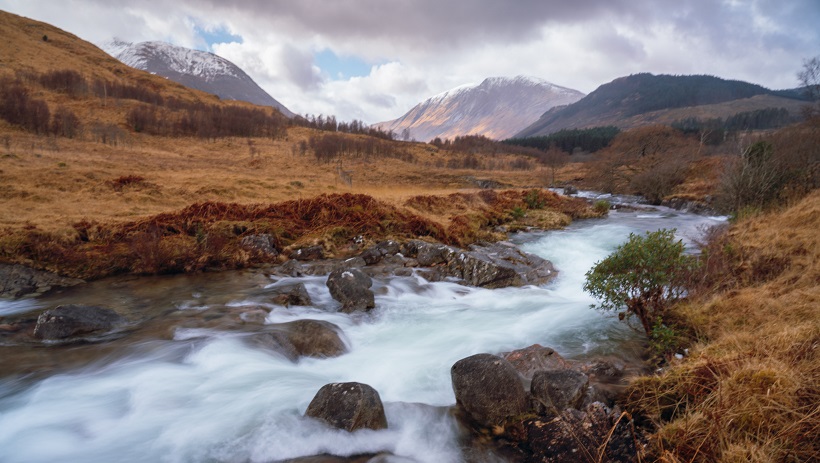
A lot has happened since my posts last month on the Glen Etive hydro schemes (see here) and (here). For almost the first time in Scotland hydro schemes are being subject to detailed scrutiny by locally elected members, informed by their knowledge and skills and the considerable public debate that has been taking place. This has already strengthened the conditions that are being applied to Hydro Planning Applications and the way these will be monitored in future. It also appears to have contributed to Highland Councillors rejecting ealier this week another hydro application, the Allt Mhuic on the north shore of Loch Arkaig. This suggests that we may be approaching something of a watershed in terms of how run of river hydro applications are decided. That is most welcome. This post takes a look at what is happening, the contribution of Highland Councillors to that process and the wider issues that need to be considered now that a proper public debate on the place of run of river hydro schemes is underway.
Update on the Etive Hydro Planning Applications
Following their visit to Glen Etive, Highland South Planning Applications Committee approved all seven planning applications at their meeting (see here for papers) on Wednesday 20th February by 7 votes to 3 (6 votes to 3 with one abstention in the case of the Allt Mheuran). The decision was met by an outpouring of public concern and activity. This has included the creation of several petitions, the creation of the Save Glen Etive Group (see here and on twiitter) (which I helping to support) and significant other campaigning activity, for example from Save Our Rivers (see here) and Mountaineering Scotland.
Meantime, even before the public had time to react two Councillors from the Committee, Andrew Baxter and Bill Lobban, had circulated a motion to fellow Councillors that the decision in the cases of the three schemes in the Wild Land Area be reconsidered by the whole Council:
“We the undersigned, being Elected Members of the Highland Council, hereby declare our wish that the decisions of the South Planning Applications Committee at its meeting on 20 February 2019 on the above applications (Agenda Items 3.2, 3.3 and 3.7) be reviewed at the next scheduled meeting of the full Council.
That petition was then supported by sufficient Councillors for the decision to be reconsidered by the full Council. (The signatories were: Mr A Baxter, Mr B Lobban, Mr M Reiss, Mrs M Cockburn, Mr A Jarvie, Dr I Cockburn, Mr A Sinclair, Mr T Heggie, Mrs A MacLean, Ms P Hadley, Mr G Cruickshank, Mr C Smith, Mrs C Caddick, Mrs I MacKenzie, Mr D Macpherson, Mr D MacKay, Mr S Mackie, Mr C Fraser, Mrs M Davidson, Mr I Ramon and Mr K Rosie) A special meeting will take place on Weds 20th March (see here for papers).
In the intervening period another meeting of the South Planning Applications Committee took place on 12th March (see here for papers). This considered two hydro scheme applications from Vento Ludens. The first which was in Glen Coe had been deferred from the meeting on 20th February and was unanimously approved. The other for the Allt Mhuic by Loch Arkaig was REJECTED by 7 votes to 6. A stunning decision.
One of the minority of Councillors who had voted for the Allt Mhuic scheme going ahead then petitioned the full Council to reconsider the decision, like the three Glen Etive schemes. At the time of writing I am not clear that they have received sufficient signatories to make this happen. I have to say that although there is a risk the refusal is overturned, I believe its the right thing to do. This is all about democracy at work. The decisions the Council takes in both this and the Glen Etive case need to be informed by as wide a debate as possible. We need that to move the whole framework for taking decisions on hydro schemes forward.
While the Developers have the right to appeal to the Scottish Government against any refusal of Planning Permission, objectors have no such rights of appeal. All that they can do is ask the Scottish Government to “call-in” an application. This rarely happens but John Mackay, who formerly worked for SNH and is a landscape expert, has formally written to the Scottish Government asking that all the Etive hydro schemes be called-in. He has been supported by Save Glen Etive (see here) and I would expect that if the full meeting of Highland Council does agree the remaining three schemes there will be a strong campaign to have them called in.
This turn of events would have been unimaginable a year ago
The context for the current debate on hydro schemes
Attitudes to hydro schemes appears to have turned almost full circle since Scottish Ministers rejected the Shieldaig Hydro scheme in Torridon back in 2004.
Soon after that Public Inquiry, perhaps as a result of growing awareness of climate change, a general assumption developed that all run of river schemes were good and would do little environmental damage. This was fed by propaganda from bodies representing the Renewables Industry. Planning decisions about hydro schemes, where ever they were located, were delegated to staff unless there were significant numbers of objections from the public. There weren’t any because the public are generally supportive of renewable energy and were ignorant of what might go wrong. The three schemes on the north side of Torridon received hardly a single objection, compared to over 600 for Shieldaig just ten years before.
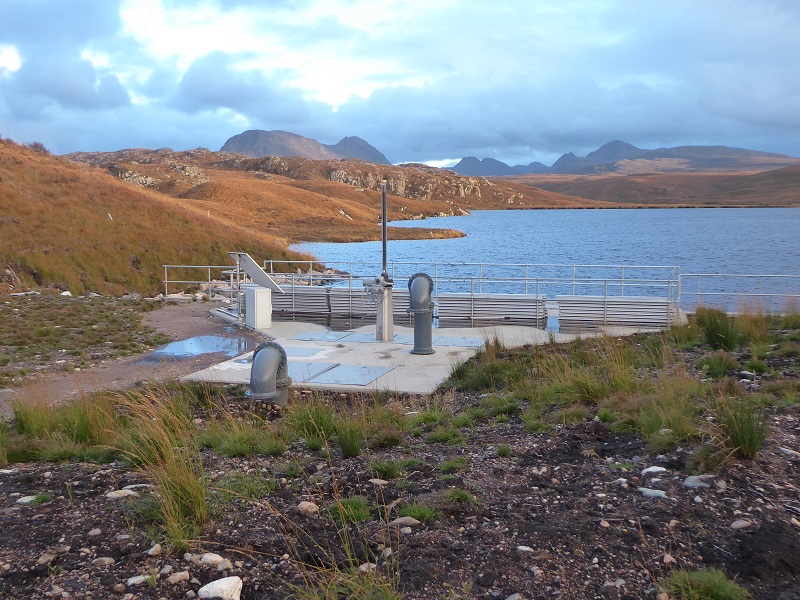
Planning staff were even more overworked and under resourced after the financial crash in 2008. Most had not enough time to critically evaluate applications let alone monitor them or develop frameworks for good practice. Added to this, Planning Authorities were under pressure from the Scottish Government to approve hydro schemes as quickly possible to take advantage of the huge subsidies they received. SNH went along with this and the Loch Lomond and Trossachs National Park Authority, which to its credit had at first taken a serious look at the planning issues, effectively abandoned trying to apply its good practice guidance on renewables after it had received a Scottish Planning Quality Award. All this meant there was no proper critical scrutiny of hydro schemes and no leadership.
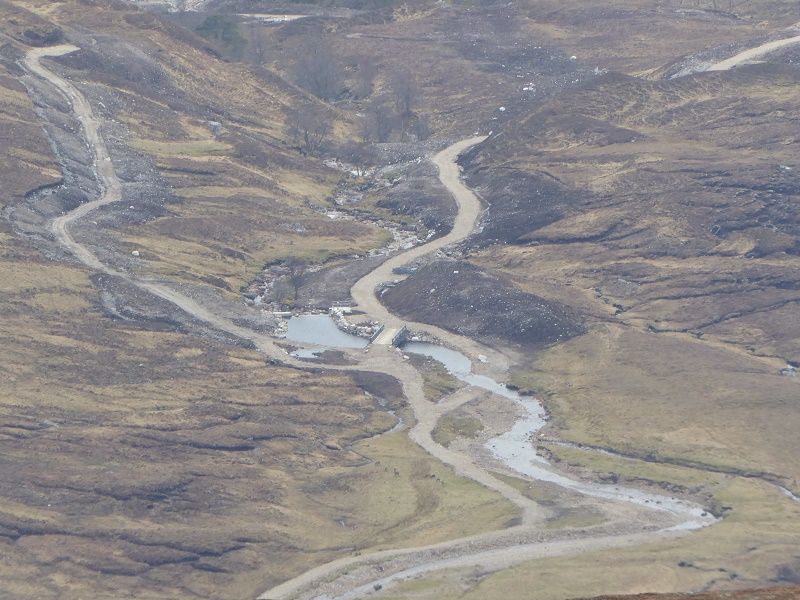
The consequence has been a rash of poorly constructed schemes across Scotland, sometimes located in inappropriate places (like Glen Affric and Torridon). While there are some examples of well designed and executed hydro schemes, these have been mainly been a consequence of landowners, developers and contractors who care rather than our planning system. In the midst of this alleged hydro bonanza no-one considered that most of the large sums of money generated by the schemes would flow straight out of the Highlands to end up in the pockets of absentee landowners and city financiers. Nor that most of these people were driven by financial interests rather than care for the natural environment and that, if allowed to get away with things, they would.
All this is now being challenged by Highland Councillors
The debate at Highland Council
Highland Council is far more open than other Planning Authorities in Scotland, including our two National Parks. All its Committee meeting are broadcast live and then publicly available for a year. While a boon to local people, who can see what their elected representatives are up to, it enables anyone to look at how decisions are made and know what they are in real time. Quite a contrast to the Loch Lomond and Trossachs National Park Authority where minutes appear often months later and important discussions, such as on the Cononish Goldmine application, are not recorded at all.
The webcasts of the South Area Planning Committee meetings from February which considered the Etive hydro schemes (see There), and from this week on the Glen Coe and Allt Mhuic schemes (see here items 6.1 and 6.2) make very interesting viewing. While long, you can skip through them. They show just how quickly the hydro debate is moving forward now that councillors are involved and giving it their full attention. This has been helped by the professionalism and honesty of the staff involved who have not tried to hide or minimise past mistakes.
To illustrate the changes that are happening:
- The South Planning Committee site visit to the 7 Glen Etive hydro schemes, while well intended, was not very productive and very time-consuming for the Councillors involved. Those Councillors able to attend (a pre-condition for being able to participate in the subsequent Committee Meeting) only viewed the schemes from the road. This meant they did not get to experience why so many people feel so passionately about the glens where the schemes are located and the weather did not help what limited views they did have. Highland Council appears to have learned from the experience because for the Allt Mhuic Scheme, which was considered just three weeks later, they commissioned drone footage of the entire site. This revolutionised the debate as Councillors were able to see what was at stake and several said how helpful this had been. There will, I understand, be drone footage of the three Etive schemes presented at the full Council Meeting next week. Staff and officers should be congratulated for this and using drone footage is a practice that should be adopted by Planning Authorities across Scotland.
- At the Etive meeting, Cllr Baxter raised issues about the adequacy of the proposed monitoring arrangements and specifically whether monthly reports to the Council were sufficient. He pointed out how a lot can go wrong in a month and how that helps explain the number of scars left across the Highlands by badly executed schemes. Officers at that meeting were resistant to change. They said they now ask for reports from the Landscape and Ecological Clerks of Works employed by the Developer to monitor these schemes on a monthly basis to be sent to them directly but thought that sufficient. A number of Councillors were concerned about this and three weeks for the Allt Mhuic Planning Application weekly monitoring reports were included as a condition of the application proceeding. That’s a significant and positive change, though it does not deal with the fundamental issue that these Clerks of Works are employed by the Developer, are not therefore independent and risk not being paid if they submit too critical reports.
- During the discussion on the Glen Coe hydro application, which is partly located in conifer plantation, Cllr Hadley asked officers about the landscape impact of the scheme once the forestry had been felled. Concerns about that is why I – and a few others – objected to all seven schemes in Glen Etive, the four located in forest plantations as well as the three in the Wild Land Area. We were concerned that the four schemes could impact on any future attempts to restore past landscape damage in the glen. That question was not asked about the Etive schemes at the South Planning Committee in February and demonstrates how the awareness of Councillors
- The most significant change of all, however, has been on hill roads. During the Allt Mhuic discussion, only one Councillor supported the proposal in the Planning Application from the Developer for a 2.5m road up to the intake (in a Wild Land Area). All the other councillors expressed serious concerns about the impact of roads in the hills on the landscape and there was reference to a number of examples associated with hydro schemes nearby (in one of which enforcement action is apparently being taken). This debate resulted in Councillors who supported the scheme producing an amendment to the Planning Application requiring the access road be reduced to ATV width, 1.8m. That’s significantly narrower to what the Loch Lomond and Trossachs National Park Authority allows but similar to what the Cairngorms National Park Authority agreed at Glen Prosen (see here) – even if that has not been delivered. It was that amended motion which was defeated. In other words the majority of Councillors thought that even the narrowest of tracks would have an UNacceptable impact on Wild Land.
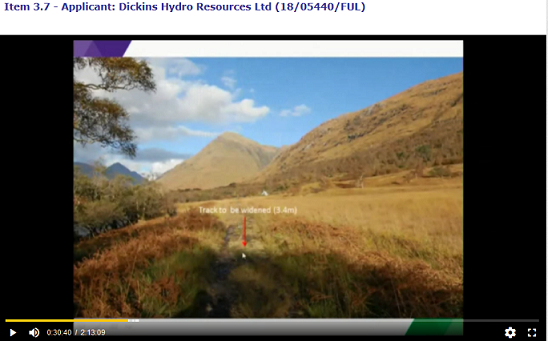
Having spent three years trying to raise awareness of the impact of poorly executed and located hydro schemes in both our National Parks, I cannot understate how brilliant it is that at last a Public Authority is having an open and transparent debate on the issues.
Its worth making a few further points about the debate:
- As a result of the lack of debate on hydro schemes to date and the lack of decisions considered by Committee, many councillors, just like the general public, are on a learning curve. The presentation on the Etive scheme by officers started with an explanation of the basic elements of hydro schemes and – to their credit – photos of what can go wrong as well as what goes right. The debate on both sides is being led by councillors who have made it their business to become informed but this still has some way to go.
- The debate is constrained by the vocabulary and frameworks available to councillors to consider issues. At both meetings there was almost as much discussion about the impact of construction traffic, whether for locals or visitors, as landscape. That I believe is because there are established frameworks for considering traffic issues and Councillors are really well briefed in this area. Inconsistent advice from Transport Scotland who had opposed a development at the bottom of Glen Coe because it turned off the A82 but were completely unconcerned about the hydro scheme turn off was jumped on by Councillors. The challenge for Councillors is that the vocabulary to talk about landscape impacts is limited to abstruse Landscape Visual Impact Assessments. These are almost completely irrelevant to deeply indented glens like Glen Etive. That’s not their fault.
- Councillors at these meetings welcomed public contributions to the debate, particularly when this set out reasoned arguments. As a result of comments submitted by Mountaineering Scotland, a Councillor raised the issue of inappropriate bright blue hydro infrastructure as a result of which officers will make a further planning condition. A small example, but showing how Councillors are interested in getting the detail of decisions right. The reasoned response to the Allt Mhuic application from the local community council was contrasted with the one line response from the Community Council at Glen Etive. It appears that Councillors are far less interested in hearing how many people oppose or support an application than in considering WHAT they have to say.
- Part of the challenge for Councillors is that other public authorities and NGOs, with the exception of Mountaineering Scotland, are not yet engaged. They are still stuck in the assumption that all hydro is good. As Cllr Baxter asked about SNH and the Allt Mhuic, how is it that the organisation that spent considerable time and expense mapping wild land areas is incapable of lifting a finger in their defence? The problem is not just SNH. The National Trust for Scotland failed even to raise concerns about the Allt Chaorainn Scheme, which is overlooked by Buachaille Etive Mor which it owns. It has been left to the Council’s officers, under their own initiative, to persuade the Developer to relocate and bury the powerhouse which would have been in full view of the famous Sky Fall layby. The John Muir Trust, after publicising that it had objected to the schemes, has been conspicuous by its silence.
- By contrast, almost all the Councillors appear to care about both renewable energy and the landscape and to appreciate the relationship between the two does need to be discussed. I have already referred to the Councillors who ended up voting for the Allt Mhuic Scheme but expressed concerns about the landscape impact of the access road. Some of these also raised concerns about the pipeline. On the other “side” the Councillors who have led the opposition to the 3 Etive and the Allt Mhuic scheme are not opposed to renewable energy in principle, just in certain places. At present their concerns are mostly focussed on the impact on Wild Land rather than National Scenic Areas. The shared concerns of councillors probably reflect those of the public appear to me to provide a firm base for the development of the debate.
Democratic scrutiny, openness and good decision making in my view go hand in hand and, whatever happens next week at the full Council when it considers the 3 Etive Planning Applications, its important the democratic debate about how hydro planning applications should be decided continues. In my view, Highland Councillors have in recent weeks shown considerable leadership in this area, leadership which has been conspicuous by its absence elsewhere.
Looking to the future
The debate about hydro schemes is essentially one about how to balance the need for more renewable energy with protecting the landscape. Unfortunately that debate has come too late to prevent all the damaging impacts that have taken place and, with the end of the Feed in Tariff, its unlikely there will be many more hydro applications in the immediate future. Glen Etive is likely to be one of the last.
Once they have taken a decision on the Etive schemes, there are two really big challenge for Councillors going forward. The first is how to ensure that schemes still being built or where restoration is still taking place have as few damaging impacts as possible. During the Allt Mhuic discussion Councillors asked for effective enforcement action to be taken at a nearby scheme. The problem is Planning Authorities, Highland included, have insufficient resources to do this.
The second, and even bigger problem, is how to restore the damage caused by schemes which are no longer covered by planning conditions (which normally last 3-5 years after a scheme is completed). This problem may well get worse in future. Once Feed In Tariffs end, it may no longer be worth some operating schemes, depending on the extent maintenance costs compared to electricity generated. Infrastructure may just be abandoned and concrete intakes left to crumble.
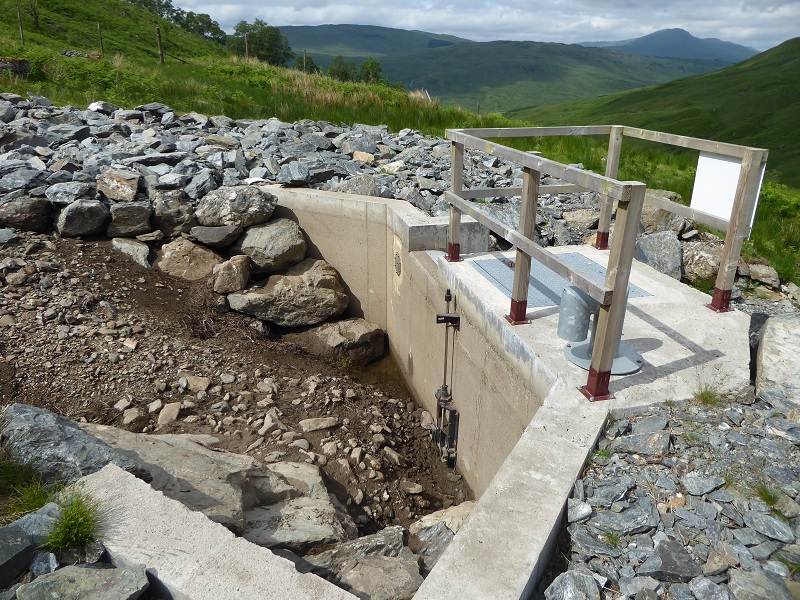
I know of no schemes where restoration bonds have been put in place by planning authorities. As hydro schemes are increasingly traded between big companies, decisions about their future are likely to be taken entirely on financial grounds.
Neither of these two challenges should be insuperable. Run of River hydro schemes at present generate large amounts of money for their owners and landowners which in many cases is siphoned out of the Highlands. The problem is how to direct some of this money back into maintaining schemes at appropriate standards and rectifying past mistakes.
One solution might lie in business rates. If Business Rate valuations reflected hydro schemes profitability, that would give local authorities a large source of income. They are short of resources of course, but if half this income was allocated to reducing the impact hydro schemes have on the natural environment, Planning Authorities could employ more staff to enforce extant planning conditions. Once these conditions had been exhausted, the resources could then be invested in a hydro restoration fund.
The big challenge going forward for Highland Councillors and members of the public who care about hydro developments, is how turn the welcome debate that has developed around the Etive hydro schemes into one that involves the Scottish Government and Public Authorities like SNH. Individual Councils cannot be expected to address the issues on their own and the concerned public need to support the Councillors who are leading this debate, respecting both “sides”.
Good piece but I think you’re a little unfair on the John Muir Trust. Perhaps you missed this – https://www.johnmuirtrust.org/latest/news/1634-trust-supports-further-discussion-on-glen-etive-hydros. The JMT has also been sharing other material online including the piece on my blog.
Thanks Chris for pointing this out and mea culpa! I have been a member of JMT for years but had not read the newsletter which arrived end of February. Whatever happens next week I suspect there will be calls on the Scottish Government to consider the case (either through the developer appealing or through a campaign to call in the application) and I do hope that whichever it is JMT will support.
Really informative article. Nice to hear that councillors are making a proper effort to get a broad view. An emphasis on what people actually say rather than just numbers is particularly heartening.
Encouraging to read about the commitment of Highlands Council to run an open and democratic planning service, which is challenging hydro schemes that would cause damage. . The hard-pressed councillors and planning officers deserve praise for this, as theirs is usually a thankless, almost invisible task.
Great info on the whole background so helpful thanks.
typo? (Unacceptable)
(4)
In other words the majority of Councillors thought that even the narrowest of tracks would have an acceptable?? impact on Wild Land.
John, thanks very much, that was a terrible type! The majority of councillors were against any track
Thank you for this analysis. It really helps inform the public. It is public pressure that must be mobilised.
During the past half century those fortunate enough have been able to enjoy journeys on foot across the unexploited Highlands. Many of those now in positions of influence grew up in an era when the commercial exploitation of the few remaining wild places had not become vastly attractive – subsidised as it now is. We looked on through a time when vast forests were planted, hillsides ploughed up, even peatlands drained for timber, and now witness the devastation after those same landscapes are “trashed” again due to clear cut felling, and sighting of pylons and wind masts.
Nevertheless , generally, the priviledge to wander for days without coming across “Infrastructure” has been a legacy of Scotland for all.
Now, due to urgent commercial pressures the final wild legacy is becoming a mess. Two decades of weak , ineffective legislation and poor planning controls has occurred. Combined with the advent of ever cheaper more powerful machines, poor control combined to extend “fingers” of the road network into wild areas where there never has been any incentive to take any vehicle.
It is this erosion of the wild spaces, the compromising of fantastic natural watercourses , the fresh runoff of material undisturbed for 25,000 years, and reduced flows due to diversion of water that is to be deplored. Surely we all have a duty to a future generation of Scots not to “trash” the final wild places just because we can, and have machinery more powerful than ever ?
The whole life energy invested in machines and materials, to ‘move mountains’ and remodel valleys, to make these small schemes work, is too often unlikely to be recouped by what scant power small generators can ever produce.
Besides permanent landscape impacts, and the often naive promises of developers promising the gullible about future “rewilding” efforts, something else is essential. Long before before any scheme can apply for planning the EIS must be broadened.. In Scotland the public must insist on an independent “whole lifetime” energy benefit anaylsis for every individual scheme proposal ?